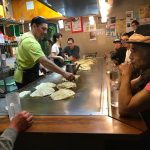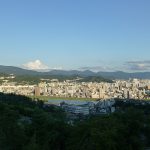
Setsubun Festivals in Hiroshima – Out With the Bad, in With the Good!
Jan 31, 2020 By Hugh Cann
Each year, on the third of February, harried fathers across Japan put on paper demon masks and are pelted with roasted soybeans by their children, who cry “Oni wa soto,...[ Click to read more ]

Sake Bank Hiroshima: Japanese Sake Tasting
Dec 26, 2019 By Hugh Cann
In my work in tourism, I’ve often had the pleasure of taking guests to breweries or to bars in other cities where we sample the delights of high-quality "nihon shu,"...[ Click to read more ]

Sushi: a Short History and Where to Get It in Hiroshima
Sep 27, 2019 By Hugh Cann
The earliest form of sushi, known today as narezushi, most likely originates in the paddy fields along the Mekong River in Southeast Asia. The prototype narezushi is made by lacto-fermenting...[ Click to read more ]

Ganko Yatai: A Night Owl’s Go-To Food Court
Aug 26, 2019 By Hugh Cann
Ganko Yatai is basically six small izakayas (Japanese taverns) wedged into one large room make up this lively spot, where beer or sake are served up with the usual izakaya...[ Click to read more ]

Live Music Venues in Hiroshima
Aug 26, 2019 By Hugh Cann
There are over half a dozen active live music venues in Hiroshima. As anywhere and according to taste and interest, some with a slick music venue feel, others quite bohemian...[ Click to read more ]

Yokogawa: Where Old and New Meet in Hiroshima
Aug 26, 2019 By Hugh Cann
Historically, Yokogawa is the old Shitamachi and before the second world war was Hiroshima's commercial business district. The post-war reconstruction shifted most commercial and retail activity to Naka -ku (ward)...[ Click to read more ]

Fukuyama, the Gem of East Hiroshima Gem
Jun 28, 2019 By Hugh Cann
Only a 30-minute bullet train ride or a 90-minute drive from Hiroshima, Fukuyama City has many gems and a big plus is that it is apparently unaffected (so far) by...[ Click to read more ]

A History of Hiroshima’s Soul-Food, Okonomiyaki
Jun 28, 2019 By Hugh Cann
Okonomiyaki (o-konomi-yaki) is often described as a Japanese savory pancake made from a variety of ingredients that includes shredded cabbage, flour, and yam-based batter, meat (generally fresh pork belly) and...[ Click to read more ]

Out Drinking in Hiroshima
May 27, 2019 By Hugh Cann
** Note: 2020.08.22 - This article is currently in the process of being updated. Please check back to confirm details.** You have had a great week and want to celebrate,...[ Click to read more ]

Hiking Mt Mitaki in Hiroshima City
May 27, 2019 By Hugh Cann
The best hike within Hiroshima City is a great bush hike to the summit of Mt Mitaki on the outskirts of the city. Mt Mitaki is best known for Mitaki-dera...[ Click to read more ]
